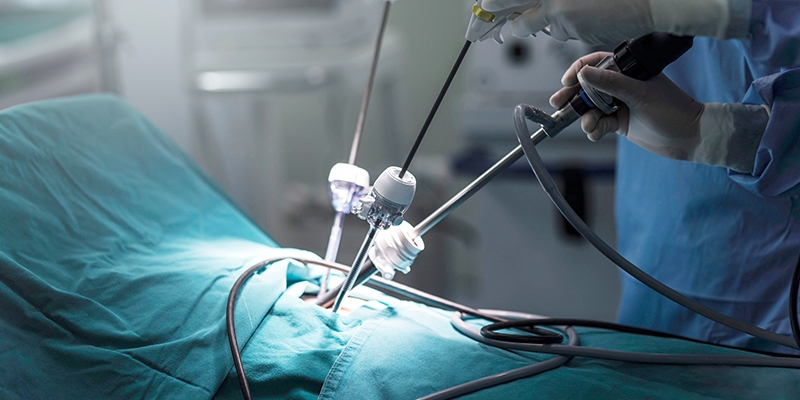There was a time that doctors had to cut open a woman in order to treat the probable cause of infertility but all that has changed with the introduction of laparoscopy.
This is a type of surgical procedure that allows a surgeon to access the inside of the abdomen (tummy) and pelvis without having to make large incisions in the skin. This procedure is also known as keyhole surgery or minimally invasive surgery.
Generally, laparoscopy is a minimally invasive surgical technique used in infertility diagnosis and treatment. It is the gold standard in diagnosing tubal pathology and other intra ‐ abdominal causes of infertility.
If you are struggling to conceive, laparoscopy allows seeing abnormalities that might interfere with your ability to conceive a pregnancy. Infertility diagnostic and operative laparoscopy help evaluate and treat gynecological problems such as uterine fibroids, structural abnormalities of the uterus, endometriosis, ovarian cysts and adhesions.
Today, the diagnosis and treatment of infertility stand out as one of the most rapidly evolving areas in medicine. Most of the tests like ultrasonography (trans-abdominal and vaginal) and hysterosalpingogram (HSG) are likely to miss intra-abdominal abnormalities such as adhesion, endometriosis, exact ovarian pathology and tubal conditions which can be easily demonstrated by laparoscopy.
The ability to see and manipulate the uterus, fallopian tubes, and ovaries during laparoscopy has made it an essential part of an infertility evaluation. This is good to know.
There is indeed a lot to know about laparoscopy which, basically, can be described as an operation involving small cuts on a woman’s tummy. A fine telescope measuring 5mm or 10 mm in diameter is introduced inside the tummy to check if the fallopian tubes are open and if there are any other undetected issues.
This helps to visualize your reproductive organs (uterus, tubes, ovaries, and the rest of the pelvis and abdomen) on the screen. Additionally, three small cuts of 5mm length may be required on the tummy to insert other instruments that are required during the laparoscopy. This procedure helps to visualize the pelvic organs.
If there is any problem, such as a tubal block, fibroid or endometriosis, it should be treated at the same sitting. If facilities and skills do not exist for the operative part, that part would have to be performed at a later date again. This leads to doubling the effort and it is advisable to be avoided. In some women, this operation gets performed repeatedly and leads to increased pain sufferings and costs.
As stated, the primary role of laparoscopy is in improving IVF success rates. For instance a proper transvaginal sonography is crucial to diagnose tubal disease, ovarian abnormalities, uterine factors, and other pelvic abnormalities that can adversely affect an IVF cycle.
Tubal disease includes infections that lead to the fluid collection within the tubes (hydrosalpinx), ovaries may have cysts and the uterus may have fibroids and polyps. If the ultrasonography has detected any of the above abnormalities, laparoscopy becomes necessary to improve the outcome of the IVF cycle.
If the fallopian tubes are infected and filled with fluid, they have to be disconnected from the uterus. If not, the unhealthy fluid can prevent the implantation of embryos in the cavity of the womb. It is important to ensure that both ovaries are free and located normally so that they are well accessible for the egg collection procedure.
Ovaries can be adherent due to adhesions resulting from conditions such as endometriosis, pelvic infections, and previous surgeries. In these situations, laparoscopy can help in the breakdown of these adhesions and free the ovaries.
If your uterus has fibroids that are large and if they are located within the cavity or near the lining of the womb, then it may be advisable to remove them. These advanced procedures need special skills and are only performed in highly specialized units.
Thankfully most women recover quickly from this procedure and can be back to normal life within 48 hours. The majority are able to go home the next day. Major surgical procedures may need an extra few days for the full recovery. A slight discomfort may be felt in the tummy for the first few days after the operation.
Laparoscopy is a very commonly performed operation with very rare complications with an incidence of less than 1 in 1000 patients. They are more seen in patients with risk factors such as previous surgery with a midline vertical incision, previous complicated abdominal surgery, and so on.
Hysteroscopy on the other hand is an operation in which a fine telescope is introduced into the cavity of the womb through its neck. Visualizing the uterine cavity and identifying the possible pathology has made hysteroscopy an equally important tool in infertility evaluation.
The question of tubal morphology and patency, ovarian morphology, any unsuspected pelvic pathology, and uterine cavity abnormalities can all be resolved with accuracy at one session.
The bottom line is that laparoscopy and hysteroscopy have an important role to improve the success of IVF treatment. Hysteroscopy is beneficial in almost every patient undergoing IVF treatment, whereas laparoscopy is done selectively as indicated.
Modern technology and improved instrumentation have increased the efficiency of these procedures. Improvement in imaging systems, better and safer energy sources for the operative procedures have increased the role of hysteroscopy and laparoscopy in maximizing the success of IVF treatment.





